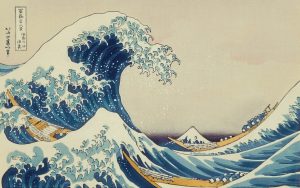
I remember that when we talked about Fuji Mountain in the lecture. Dr Dierkes told us that Fuji Mountain is important and divine to Japanese people, and it often appeared in the Japanese artworks. The first thing came to my mind is the picture of “Kanagawa Oki Nami Ura” or “The Great Wave off Kanagawa”.
I can not describe how much I love this painting. I set this as the desktop imagine of my laptop, that means I can see this superb painting everyday. More commonly, I always can see this painting on the wall of Japanese restaurant, even though the restaurant may be operated by Korean or Chinese. Behind this, Kanagawa Oki Nami Ura is the symbol of Japanese culture, admittedly.
In this blog, I will do a basic introduction to this world-famous painting and talk about my personal feelings about Kanagawa Oki Nami Ura. In the following, I will simply call it The Wave.
The Wave was painted by ukiyo-e artist Hokusai around 1830-1832 (Metropolitan Museum of Arts, 2010) from Hokusai’s series Thirty-six Views of Mount Fuji. And The Wave is the first one of the series. It depicts the huge wave raised near the coast of Kanagawa. Three boats were drawn into the tremendous wave while there are fishermen on the deck of the boats. And the Fuji Mountain can be seen in the faraway place (British Museum, 2013).
In the upper left is the title of this painting and the signature of author. And there are three main elements in the picture: boats (including the people on the boat), huge wave and Fuji Mountain. I will analyze them respectively in the following.
Boats
Kabayashi and Harbison believes that the boats were used to fish catching and transportation (Kabayashi & Harbison, 1997). There were eight rowers take charge of quants per boat.And two more passenger we can see on the front part of the boat. From this picture, we can see all the people on boat is very stiff and seems like crawled on the deck of boats. I assume that they were terrified by the huge wave and just pray their kami to bless them. And this picture formed a vivid comparison to the wave. While the waves are full of vatality and fury. I think that at that moment, Japanese hold in awe and veneration to the nature.
The Waves
The waves are vivid. It rolled close to the sky. The very front just like numberless tentacles of sea monster. And they were just rush at the boats. The water drop from the front of waves fall down. just seems like snowfall to the Fuji Mountain. I like this view, it is full of orientally poetic and marvellous. Some people regarded the huge waves as tsunami, but Cartwright and Nakamura denied this hypothesis in their article What kind of a wave is Hokusai’s Great wave off Kanagawa (Cartwright & Nakamura, 2009). The Waves just huge waves rather than tsunami.
The Fuji Mountain
We can see the Fuji mountain is in the centre of the whole painting. And the peak of the Fuji Mountain is covered by snow. The color of the mountain is indigo, it full of tranquility. The artist paints the Fuji quite small compared to the huge waves (Chiba City Museum of Arts, 2013). It demonstrate the awe and hugeness of the waves. This is a bold and innovative painting technique at that age.
This is just a very brief introduction to the Kanagawa Oki Nami Ura. And because of this painting, I learn more about Ukiyo-e, this kind of art.
References:
- Cartwright, Julyan H. E; Nakamura, Hisami (2009). What kind of a wave is Hokusai’s Great wave off Kanagawa? Notes and Records of the Royal Society. DOI: 10.1098/rsnr.2007.0039.
- The Great Wave off Kanagawa. (2017, Sep 13). In Wikipedia. Retrieved October 1, 2017, from https://en.wikipedia.org/wiki/The_Great_Wave_off_Kanagawa
- Kanagawa-oki nami-ura 神奈川沖浪裏 (Under the Wave off Kanagawa). (2014, December 14). In British Museum. Retrieved October 1, 2017, from http://www.britishmuseum.org/research/collection_online/collection_object_details.aspx?objectId=3097579&partId=1
- Kanagawa Oki Nami Ura. (2013, Febury 05). In Chiba City Museum of Arts. Retrieved October 1, 2017, from http://www.ccma-net.jp/collection_img/collection_02-06_hokusai.html
- Katsushika Hokusai: The Great Wave at Kanagawa. (2010, June 14). In Metropolitan Museum of Art. Retrieved October 1, 2017, from http://www.metmuseum.org/toah/works-of-art/JP1847/
- Kobayashi, Tadashi; Harbison, Mark (1997). Ukiyo-e: an introduction to Japanese woodblock prints. Kodansha International. ISBN 978-4-7700-2182-3.
